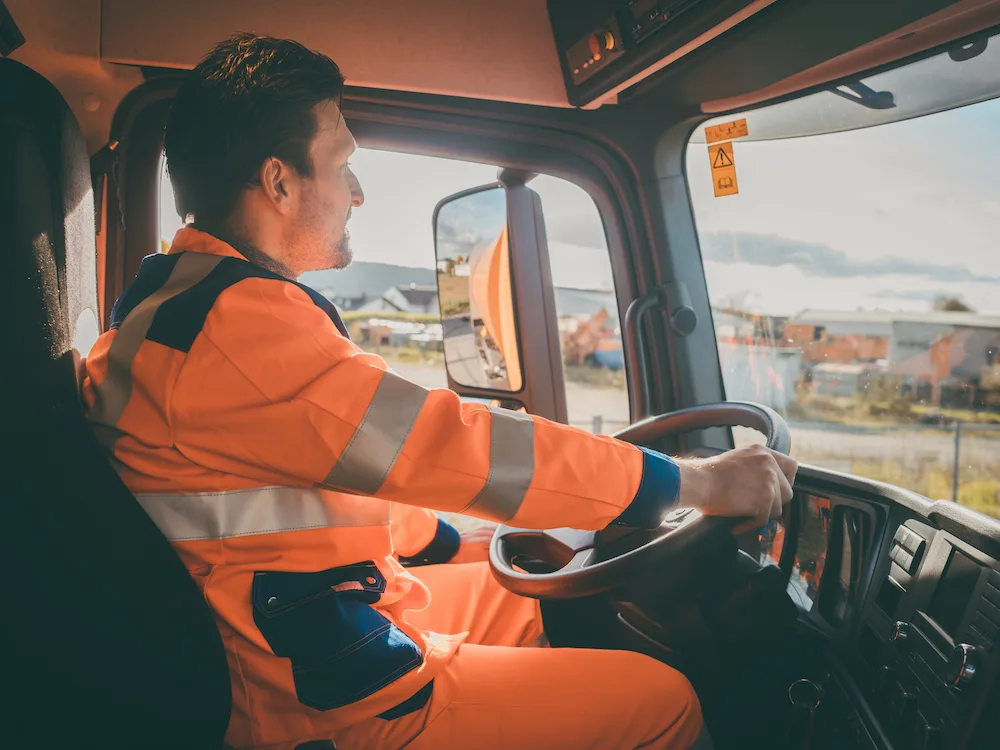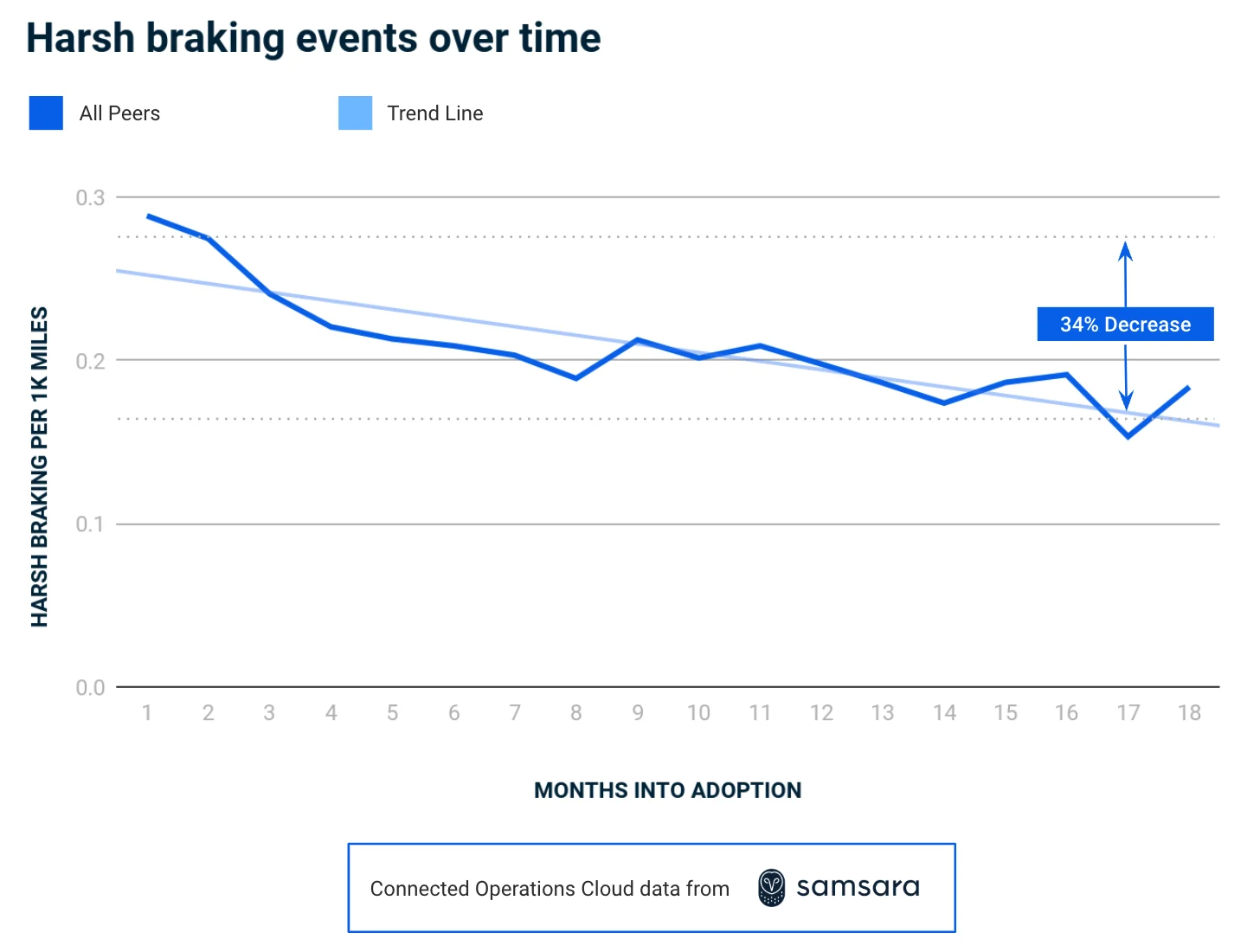Data Insights & Analytics
For National Safety Month, See How Samsara Reduces Harsh Braking
June 6, 2023

Growth Marketing Manager

Incidents can happen to even the safest drivers, but it's a fact that sudden, hard braking—also called harsh braking—is highly associated with on-the-road crashes for commercial drivers. In fact, one study found that harsh braking is the most likely predictor of future crashes.
For fleets, the problem is magnified. A fully loaded tractor-trailer traveling at 65 miles per hour will take almost the length of two football fields to stop. In other words, if a truck driver uses harsh braking to try and avoid a collision, there likely just isn't enough room or time to do so.
Staying safe is a priority year round, but June marks National Safety Month, an annual observance organized by the National Safety Council (NSC). This year, the NSC is focusing on hazard recognition—for drivers, this would mean observing dangers and thoughtfully braking to avoid them—as a key factor that can help improve safety. For these reasons, it's an ideal time to take a closer look at what the data says about harsh braking, as well as how Samsara can help fleet operators reduce harsh driving events, such as harsh braking, turns, and acceleration, and make the roads safer for everyone.
Truck crashes are closely associated with harsh braking.
The number of crashes involving trucks is on the rise. In 2021, almost 6,000 large trucks were involved in a fatal crash, an increase of 18% from 2020. Over the last 10 years, the numbers are even more dramatic, with fatal truck crashes rising by 49%.
Harsh braking is closely correlated with crashes. In fact, one recent study looking at incidents in construction zones found that approximately one crash occurred for every 147 hard-braking events per mile. The Federal Motor Carrier Safety Administration (FMCSA) has also found that driver "decision" events—including actions such as following too closely or driving too fast, which often lead to harsh braking—cause 38% of large truck crashes.
Aside from safety considerations, harsh braking causes poor fuel economy. A recent study found that every hard braking incident increases fuel consumption by as much as a half-gallon of fuel. With high fuel prices, it's easy to see how harsh braking incidents can add up over time and significantly impact an organization's bottom line.
Samsara solutions to improve coaching and reduce harsh driving.
Technology is changing the way that fleets detect and manage unsafe driving, and Samsara has developed a range of products and features that are purpose-built to help empower drivers to reduce harsh braking.
For example, Samsara’s Vehicle Telematics solution gives fleets accurate data on driver behavior and harsh braking incidents. In addition, Samsara’s Video-Based Safety solution provides in-cab coaching to proactively alert drivers to self-correct these behaviors on the road. Safety managers can use video footage of behaviors like tailgating and harsh braking to understand why these incidents happen, and coach drivers more effectively.
Moreover, fleets can utilize the Samsara Driver App and Safety Scores to identify high- and low-performing drivers and leverage gamification to build rewards programs. With performance data in hand, managers can ensure that they are coaching the drivers who need it most while incentivizing drivers to build safe habits and boost overall engagement.
34% reduction in harsh braking with Samsara Video-Based Safety and Vehicle Telematics.
We wanted to understand harsh driving behavior in fleets that have the Samsara Video-Based Safety and Vehicle Telematics solutions. To do this, we examined aggregate data from the Samsara Connected Operations™ Cloud, and observed a notable reduction in harsh braking events for the customers evaluated. Fleets that have Samsara Vehicle Gateways, and then deploy Samsara AI Dash Cams, see harsh braking decline by 34% across an 18-month period. (See Methodology section below for more details.)

A range of Samsara customers have reported similar results in their day-to-day operations. For example, Univar Solutions, the largest chemical and ingredient distributor in North America, uses Samsara’s Video-based Safety Solution to deliver proactive coaching when incidents occur. As a result, Univar has achieved a 40%+ decrease in harsh events across their fleet.
Dohrn Transfer Company is another example. Dohrn is a less-than-truckload carrier that provides trucking services and local delivery across the United States. With Video-Based Safety from Samsara, the company has transformed their safety program and reduced harsh events by 88%. Moreover, Dohrn has used Samsara Safety Scores to reduce driver turnover by 10% and $8,000 in recruitment and replacement costs per driver.
Reduce harsh events, like harsh braking, with Samsara.
Connecting telematics data about harsh braking to video can provide more context around these incidents, making the combination of Video-Based Safety and Vehicle Telematics a powerful tool safety managers can use to coach drivers more effectively and reduce harsh braking events. If you're interested in exploring more about how maximizing the use of the Samsara Connected Operations™ Cloud can help you reduce harsh braking, and improve driver safety overall, click here.
Methodology
The statistics shown are based on anonymized historical data of 263 Samsara telematics-only customers in the United States and Canada who then added 10 or more Samsara AI Dash Cams after an initial three-month onboarding period.
Comparisons of harsh braking statistics were based on measurements of harsh braking as detected by Samsara Vehicle Gateways. Samsara analyzed the first 18 months of adoption for each customer, all of which started using Samsara in 2021 or later, and were using AI Dash Cams for at least 24 months. The reduction was measured by looking at harsh braking in months one through three after deployment and comparing them to the three-month period 15 to 18 months after deployment.
The percent improvement was calculated by comparing the average of the first three months and the average of the last three months of each customer’s first 18 months with Samsara AI Dash Cams after initial usage of Samsara Vehicle Gateways.
Results vary by individual customer and are not guaranteed.





